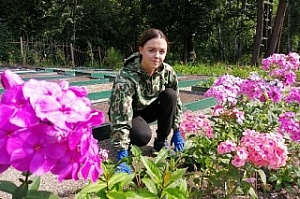TSU Botanical Garden (SibBG), which will celebrate its 140th anniversary in August 2020, is preparing a new exposition on planting and breeding rare plants brought by the staff from expeditions. The exhibition will also serve as a place to preserve the Botanical Garden's flower collections.
- For 140 years, many collections have been created in the Siberian Botanical Garden. To preserve and increase them, additional space is required, - says Mikhail Yamburov, director of SibBG TSU. – Arrangements began two years ago, in the area where greenhouses were located in the Soviet years. Now, plants are transferred here from different sites, including the experimental one located on Mokrushina Street.
At the same time, every year SibBG staff go on expeditions and bring back rare and endangered plants that are of interest to research. It is not known how they will behave in the new conditions, so they will be placed in some isolation from the main collections. As Mikhail Yamburov notes, the new exposition has not only scientific but also educational value. Students of the TSU Biological Institute will practice here, and classes will be conducted for schoolchildren.
In the development and design of the site, the SibBG staff is assisted by students employed through the UniProfi online exchange. Students from Russia, Equatorial Guinea, and Indonesia, who are studying at the Institute of Applied Mathematics and Computer Science, Biological and Legal Institutes, Faculty of Physics, Faculty of Historical and Political Studies, and other faculties of the university, work at the exhibition.
- We always need working hands, because the area of the Botanical Garden is about 120 hectares, - says Alina Butenkova, deputy director of the TSU SibBG. - Students work both in the main area and on the educational and experimental sites. Its covers 115 hectares, and there are large dendrological collections, a collection of medicinal plants, and much more. The guys from the stock exchange also work there, which helps to solve urgent tasks of caring for funds.
In addition to getting a salary and new experience, students also boost their language skills. For example, the future IT specialist Juan Manuel (Equatorial Guinea) and the future political scientist Akila Salma (Indonesia) already easily communicate with scientists and other students in Russian.

- My parents have a vegetable garden, so I have worked with a shovel before, - says Juan Manuel, a student of the Institute for the Mathematical Sciences. - But here, of course, I learned much more. I learned the names of many new colors. I ask scientists how plants are called and try to remember everything they say.
At present, 36 people from the labor exchange work in the Botanical Garden. In the coming days, the number of students will increase even more, because there is a lot of work on the eve of the anniversary. They not only take part in arranging the new exposition (laying paths, planting plants), they help to put everything in order - they are engaged with the staff in cleaning up garbage and emergency trees and taking care of parterre flower beds.
- The new exposition is now in the stage of actively forming, - explains Alexey Prokopyev, head of the laboratory of rare plants at the Siberian Branch of the Russian Academy of Sciences. - It takes time for the planted specimens to start, so the exposition will get its proper form in the spring–summer of 2021. We hope that there will no longer be any restrictions associated with the pandemic and guests of the Botanical Garden will be able to see ornamental and rare plan

